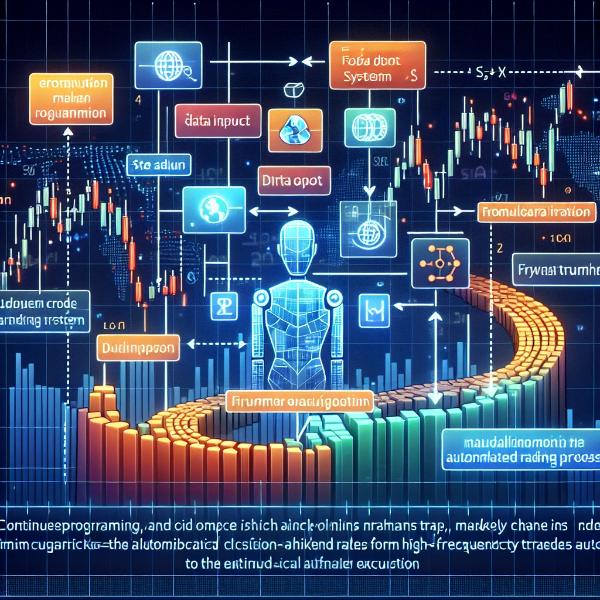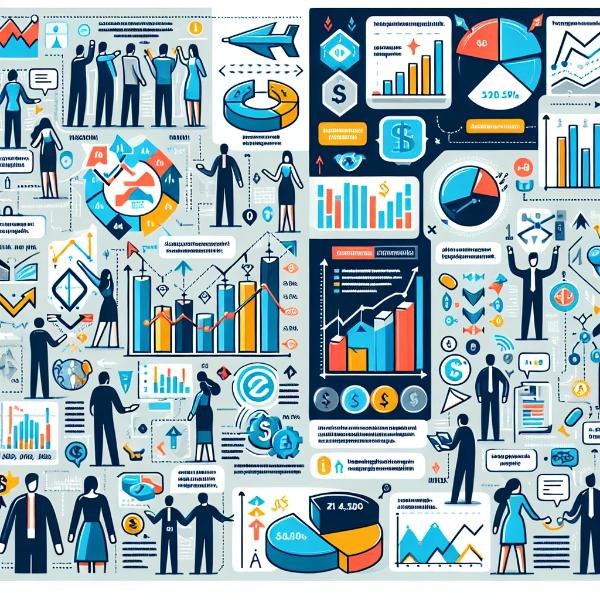Decoding the Inner Workings of Forex Robots: Unveiling the Secrets Behind Their Functionality

Forex robots have become increasingly popular in the world of online trading. These automated systems are designed to trade on your behalf, using complex algorithms and mathematical models to analyze market trends and make trading decisions. But how do they actually work?
Forex robots are programmed to follow a set of rules and parameters that determine when to enter or exit trades. They are constantly monitoring the market, looking for profitable opportunities based on the indicators and strategies they are programmed with.
When a potential trade is identified, the forex robot will execute the trade automatically, without any human intervention. This eliminates the emotional aspect of trading, as robots are not influenced by fear or greed. They simply follow the rules they have been programmed with.
These robots can analyze vast amounts of data in a matter of seconds, much faster than any human trader could. They can also trade 24 hours a day, 5 days a week, without the need for breaks or sleep. This allows them to take advantage of trading opportunities that may arise at any time.
While forex robots can be a valuable tool for traders, it’s important to understand that they are not infallible. Market conditions can change rapidly, and a robot’s performance can be affected by unforeseen events or sudden shifts in market sentiment.
Ultimately, the success of a forex robot depends on the quality of its programming and the strategies it employs. It’s important to choose a reputable robot and to regularly monitor its performance to ensure it is still aligned with your trading goals.
So, if you’re looking to automate your trading and take advantage of the benefits that forex robots offer, it’s crucial to understand the mechanism behind them and how they work. With the right robot and a solid understanding of the market, you can potentially increase your chances of success in the world of forex trading.
Understanding the Mechanism Behind Forex Robots
Forex robots, also known as expert advisors (EAs), have become increasingly popular in the world of online trading. These automated systems are designed to trade on behalf of the user, utilizing complex algorithms and mathematical models to analyze market data and make trading decisions.
At the core of every forex robot is a set of rules or strategies that guide its trading activities. These rules are based on various technical indicators, such as moving averages, trend lines, and oscillators, which help the robot identify potential trading opportunities.
Once a forex robot identifies a trading signal based on its predefined rules, it automatically executes the trade on the user’s behalf. This eliminates the need for manual intervention and allows traders to take advantage of market opportunities 24 hours a day, 5 days a week.
Forex robots are programmed to follow strict risk management rules to protect the user’s capital. They can set stop-loss and take-profit levels to limit potential losses and secure profits. Additionally, some robots employ advanced money management techniques, such as adjusting position sizes based on account balance or equity, to optimize returns and minimize risk.
It’s important to note that while forex robots can be powerful tools, they are not foolproof. Market conditions can change rapidly, and unexpected events can cause significant fluctuations in currency prices. Therefore, it’s crucial for traders to regularly monitor their robots’ performance and make necessary adjustments to ensure optimal results.
In conclusion, forex robots offer traders the opportunity to automate their trading activities and potentially increase their profitability. However, understanding the mechanism behind these robots is essential for users to make informed decisions and effectively utilize these tools in the dynamic forex market.
What are Forex Robots?
Forex robots, also known as expert advisors (EAs), are automated trading systems that execute trades on behalf of traders in the forex market. These robots are designed to analyze market conditions, identify trading opportunities, and execute trades based on pre-defined parameters and strategies.
Forex robots use complex algorithms and mathematical models to analyze vast amounts of data, including historical price movements, economic indicators, and market trends. They can quickly process and interpret this data to make informed trading decisions.
One of the main advantages of using forex robots is their ability to trade 24/7 without the need for human intervention. They can monitor the market continuously, identify potential trading opportunities, and execute trades instantly, even when the trader is not available.
Forex robots can be programmed to follow specific trading strategies, such as trend following, scalping, or breakout trading. Traders can customize the parameters and settings of the robot to align with their trading preferences and risk tolerance.
While forex robots can be a valuable tool for traders, it’s important to note that they are not a guaranteed path to success. Market conditions can change rapidly, and past performance is not always indicative of future results. Traders should carefully research and test any forex robot before using it with real money.
In conclusion, forex robots are automated trading systems that can execute trades in the forex market based on pre-defined parameters and strategies. They use complex algorithms and mathematical models to analyze market data and make informed trading decisions. While they can be a useful tool, traders should exercise caution and conduct thorough research before relying solely on forex robots for trading.
Importance of Understanding Their Mechanism
Understanding the mechanism behind Forex robots is crucial for anyone interested in trading on the foreign exchange market. These automated systems are designed to execute trades on behalf of the trader, using pre-programmed algorithms and strategies.
By understanding how these robots work, traders can make informed decisions about whether to use them and how to optimize their performance. Here are some key reasons why understanding their mechanism is important:
| 1. Making Informed Decisions
By understanding the mechanism behind Forex robots, traders can evaluate the effectiveness and reliability of different systems. This knowledge allows them to make informed decisions about which robots to use and which ones to avoid. It also helps traders assess the risks and potential rewards associated with using automated trading systems. |
| 2. Optimizing Performance
Understanding how Forex robots work enables traders to optimize their performance. By analyzing the algorithms and strategies used by the robots, traders can identify potential weaknesses or areas for improvement. They can then make adjustments to the settings or parameters of the robot to enhance its performance and increase the chances of making profitable trades. |
| 3. Avoiding Pitfalls
Without understanding the mechanism behind Forex robots, traders may fall into common pitfalls and make costly mistakes. For example, they may rely too heavily on the robot’s recommendations without considering other factors or market conditions. They may also fail to monitor the robot’s performance or adjust its settings as needed. By understanding how these robots work, traders can avoid these pitfalls and use the robots as effective tools in their trading strategies. |
| 4. Enhancing Trading Skills
Understanding the mechanism behind Forex robots can also help traders enhance their own trading skills. By studying the algorithms and strategies used by the robots, traders can gain insights into market trends, patterns, and indicators. This knowledge can then be applied to manual trading, allowing traders to make more informed decisions and improve their overall trading performance. |
In conclusion, understanding the mechanism behind Forex robots is essential for traders who want to effectively use these automated systems. It allows them to make informed decisions, optimize performance, avoid pitfalls, and enhance their trading skills. By investing time and effort into understanding how these robots work, traders can increase their chances of success in the foreign exchange market.
How Do Forex Robots Work?
Forex robots, also known as automated trading systems or expert advisors, are computer programs designed to automatically execute trades in the foreign exchange market. These robots use complex algorithms and mathematical models to analyze market data and make trading decisions.
Forex robots work by constantly monitoring the market and identifying potential trading opportunities based on predefined criteria. These criteria can include technical indicators, price patterns, and other factors that indicate a high probability of a profitable trade.
Once a trading opportunity is identified, the forex robot will automatically execute the trade on behalf of the trader. This eliminates the need for manual intervention and allows the robot to take advantage of market opportunities 24 hours a day, 7 days a week.
Forex robots can be programmed to trade according to specific strategies or trading systems. Some robots are designed to scalp the market, aiming to make small profits on multiple trades throughout the day. Others may be programmed to follow trend-following or breakout strategies, aiming to capture larger profits from longer-term market movements.
Forex robots can also incorporate risk management techniques, such as stop-loss orders and take-profit levels, to protect the trader’s capital and maximize potential profits. These robots can be customized to fit the trader’s risk tolerance and trading preferences.
It is important to note that while forex robots can be highly effective in executing trades and generating profits, they are not infallible. Market conditions can change rapidly, and there is always a risk of losses in trading. Traders should carefully evaluate and test any forex robot before using it with real money.
In conclusion, forex robots are powerful tools that can automate trading in the foreign exchange market. They work by analyzing market data, identifying trading opportunities, and executing trades based on predefined criteria. Traders should exercise caution and conduct thorough research before using a forex robot.
Data Analysis and Algorithm Development
Data analysis and algorithm development play a crucial role in the functioning of Forex robots. These robots rely on complex algorithms and data analysis techniques to make informed trading decisions.
When it comes to data analysis, Forex robots gather and analyze vast amounts of historical and real-time market data. This includes price movements, volume, trends, and other relevant indicators. By analyzing this data, the robots can identify patterns and trends that humans may overlook. They can also detect potential trading opportunities and predict market movements with a high degree of accuracy.
Algorithm development is another key aspect of Forex robot functionality. Algorithms are sets of rules and instructions that guide the robot’s decision-making process. These algorithms are developed based on extensive research, mathematical models, and statistical analysis. The goal is to create algorithms that can adapt to changing market conditions and make profitable trades.
Forex robots use various types of algorithms, including trend-following algorithms, mean-reversion algorithms, and breakout algorithms. Trend-following algorithms aim to identify and capitalize on market trends, while mean-reversion algorithms look for opportunities to trade against the prevailing trend. Breakout algorithms focus on identifying potential breakouts and entering trades at the early stages of a new trend.
Developing effective algorithms requires a deep understanding of market dynamics, technical analysis, and statistical modeling. Forex robot developers often employ teams of experienced traders, mathematicians, and computer scientists to design and refine their algorithms. They continuously test and optimize the algorithms to ensure they remain effective in different market conditions.
In conclusion, data analysis and algorithm development are critical components of Forex robot functionality. By analyzing vast amounts of data and using sophisticated algorithms, these robots can make informed trading decisions and generate consistent profits in the Forex market.
Automated Trading Execution
Automated trading execution is a key feature of forex robots that sets them apart from manual trading. With automated trading, the forex robot is programmed to execute trades on behalf of the trader based on predefined rules and algorithms.
When a forex robot is set up, it continuously monitors the market conditions and analyzes various factors such as price movements, technical indicators, and news events. Based on this analysis, the robot identifies trading opportunities and executes trades automatically without the need for human intervention.
One of the advantages of automated trading execution is its speed and efficiency. Forex robots can process vast amounts of data and make trading decisions in a fraction of a second. This allows them to take advantage of even the smallest market fluctuations and execute trades at the most favorable prices.
Another benefit of automated trading is its ability to remove human emotions from the trading process. Emotions such as fear and greed can often cloud judgment and lead to impulsive and irrational trading decisions. Forex robots, on the other hand, operate purely based on logic and predefined rules, eliminating the influence of emotions.
Furthermore, automated trading execution allows traders to take advantage of 24/7 market opportunities. Since forex robots can operate continuously without the need for sleep or breaks, they can monitor the market and execute trades even when the trader is not available.
Overall, automated trading execution offers traders a range of benefits, including speed, efficiency, emotion-free trading, and the ability to capitalize on round-the-clock market opportunities. By leveraging the power of forex robots, traders can enhance their trading strategies and potentially increase their profitability in the forex market.
Monitoring and Adjusting Strategies
Monitoring and adjusting strategies is a crucial aspect of using forex robots effectively. While these automated systems are designed to trade on your behalf, it is essential to regularly monitor their performance and make necessary adjustments to ensure optimal results.
Here are some key strategies for monitoring and adjusting forex robots:
- Regular Performance Evaluation: It is important to regularly evaluate the performance of your forex robot. This can be done by analyzing its trading history, including the number of trades executed, profits and losses, and overall success rate. By monitoring its performance, you can identify any patterns or issues that need to be addressed.
- Setting Realistic Expectations: While forex robots can be highly effective, it is important to set realistic expectations. Not every trade will be profitable, and there will be periods of losses. By understanding the limitations of the robot and setting realistic goals, you can avoid unnecessary disappointment and make informed adjustments when necessary.
- Adjusting Risk Parameters: Forex robots often come with various risk parameters that can be adjusted to suit your trading preferences. These parameters include stop-loss levels, take-profit targets, and trade size. By regularly reviewing and adjusting these parameters, you can optimize the robot’s performance and minimize potential risks.
- Keeping Up with Market Conditions: The forex market is constantly changing, and it is important to stay updated with the latest market conditions. This includes monitoring economic news, geopolitical events, and technical indicators. By staying informed, you can make necessary adjustments to your forex robot’s trading strategy to adapt to changing market conditions.
- Backtesting and Optimization: Backtesting involves testing the performance of a forex robot using historical data. By backtesting different strategies and parameters, you can identify the most effective settings for your robot. Optimization involves fine-tuning the robot’s parameters based on the backtesting results to maximize its performance.
By implementing these monitoring and adjusting strategies, you can ensure that your forex robot is performing optimally and maximizing your trading potential. Remember, while forex robots can automate trading processes, they still require regular monitoring and adjustments to adapt to changing market conditions and achieve desired results.
Benefits and Limitations of Forex Robots
Forex robots, also known as expert advisors, have gained popularity in the world of forex trading due to their potential benefits. However, it is important to understand their limitations as well. Here are some of the benefits and limitations of using forex robots:
Benefits:
- Automation: Forex robots automate the trading process, allowing traders to execute trades automatically based on predefined rules and algorithms. This eliminates the need for manual trading and saves time.
- Emotion-free trading: Forex robots are not influenced by emotions such as fear or greed, which can often lead to irrational trading decisions. They strictly follow the programmed rules, leading to more disciplined trading.
- 24/7 Trading: Forex robots can trade 24 hours a day, 7 days a week, without the need for human intervention. This allows traders to take advantage of trading opportunities even when they are not actively monitoring the market.
- Backtesting and Optimization: Forex robots can be backtested and optimized using historical data, allowing traders to evaluate their performance and make necessary adjustments to improve profitability.
- Diversification: Forex robots can trade multiple currency pairs simultaneously, diversifying the trading portfolio and potentially reducing the overall risk.
Limitations:
- Lack of Adaptability: Forex robots are programmed to follow specific rules and algorithms, which may not adapt well to changing market conditions. They may perform well in certain market conditions but struggle in others.
- Dependency on Historical Data: Forex robots rely on historical data for backtesting and optimization. However, past performance does not guarantee future results, and market conditions can change unpredictably.
- No Emotional Intelligence: Forex robots lack emotional intelligence and cannot make subjective judgments or adapt to unexpected events. They strictly follow the programmed rules, which may not always be suitable in certain market situations.
- Technical Issues: Forex robots are software programs and can be prone to technical issues or malfunctions. This can lead to missed trading opportunities or incorrect execution of trades.
- Over-Optimization: There is a risk of over-optimizing forex robots based on historical data, which can lead to curve-fitting and poor performance in live trading conditions.
While forex robots offer potential benefits such as automation and emotion-free trading, it is important to understand their limitations and use them as a tool in conjunction with human judgment and analysis.
Advantages of Forex Robots
Forex robots, also known as expert advisors, offer several advantages for traders in the foreign exchange market. Here are some of the key benefits:
- 24/7 Trading: Forex robots can trade round the clock, without the need for human intervention. This allows traders to take advantage of market opportunities even when they are not actively monitoring the market.
- Emotion-Free Trading: One of the biggest advantages of using forex robots is that they eliminate the influence of emotions in trading decisions. Robots are programmed to follow a set of predefined rules and execute trades based on technical indicators, without being swayed by fear or greed.
- Consistency: Forex robots are designed to stick to a trading strategy consistently. They do not deviate from the plan, ensuring that trades are executed according to the predetermined rules. This helps to maintain discipline and avoid impulsive trading decisions.
- Speed and Efficiency: Forex robots can analyze market conditions and execute trades much faster than humans. They are capable of processing large amounts of data and making split-second decisions, which can be crucial in a fast-paced market.
- Backtesting and Optimization: Forex robots can be backtested and optimized using historical market data. This allows traders to fine-tune their strategies and identify the most profitable settings before deploying the robot in live trading.
- Diversification: Forex robots can be programmed to trade multiple currency pairs simultaneously, diversifying the trading portfolio. This can help to spread the risk and potentially increase profitability.
Overall, forex robots offer traders the opportunity to automate their trading strategies, eliminate emotional bias, and take advantage of market opportunities 24/7. However, it is important to note that forex robots are not foolproof and should be used with caution. Traders should always monitor their performance and make adjustments as necessary.
Question-Answer:
What is a forex robot?
A forex robot is an automated trading software that executes trades on behalf of the user in the foreign exchange market.
How do forex robots work?
Forex robots work by analyzing market data, identifying trading opportunities, and automatically executing trades based on pre-defined parameters and strategies.
Can forex robots make profitable trades?
Yes, forex robots have the potential to make profitable trades. However, their success depends on the accuracy of their algorithms and the market conditions.
What are the advantages of using forex robots?
Using forex robots can save time and effort as they can trade automatically. They can also eliminate emotional trading decisions and can execute trades faster than humans.
Are forex robots suitable for beginners?
Forex robots can be suitable for beginners as they can help automate the trading process. However, it is important for beginners to understand the basics of forex trading before relying solely on a robot.
What is a forex robot?
A forex robot is an automated trading software that executes trades on behalf of a trader in the foreign exchange market.
How does a forex robot work?
A forex robot works by analyzing market data, identifying trading opportunities, and automatically executing trades based on predefined rules and algorithms.
Can a forex robot make profitable trades?
Yes, a forex robot can make profitable trades if it is programmed with a successful trading strategy and is able to adapt to changing market conditions.
What are the advantages of using a forex robot?
The advantages of using a forex robot include the ability to trade 24/7, the elimination of emotional trading decisions, and the potential for increased trading efficiency.
Are there any risks involved in using a forex robot?
Yes, there are risks involved in using a forex robot. The performance of a forex robot is dependent on the accuracy of its algorithms and the quality of its programming. Additionally, market conditions can change rapidly, which can affect the profitability of trades executed by the robot.
What is a forex robot?
A forex robot is a computer program that is designed to automatically execute trades in the forex market. It uses a set of predefined rules and algorithms to analyze market conditions and make trading decisions.






